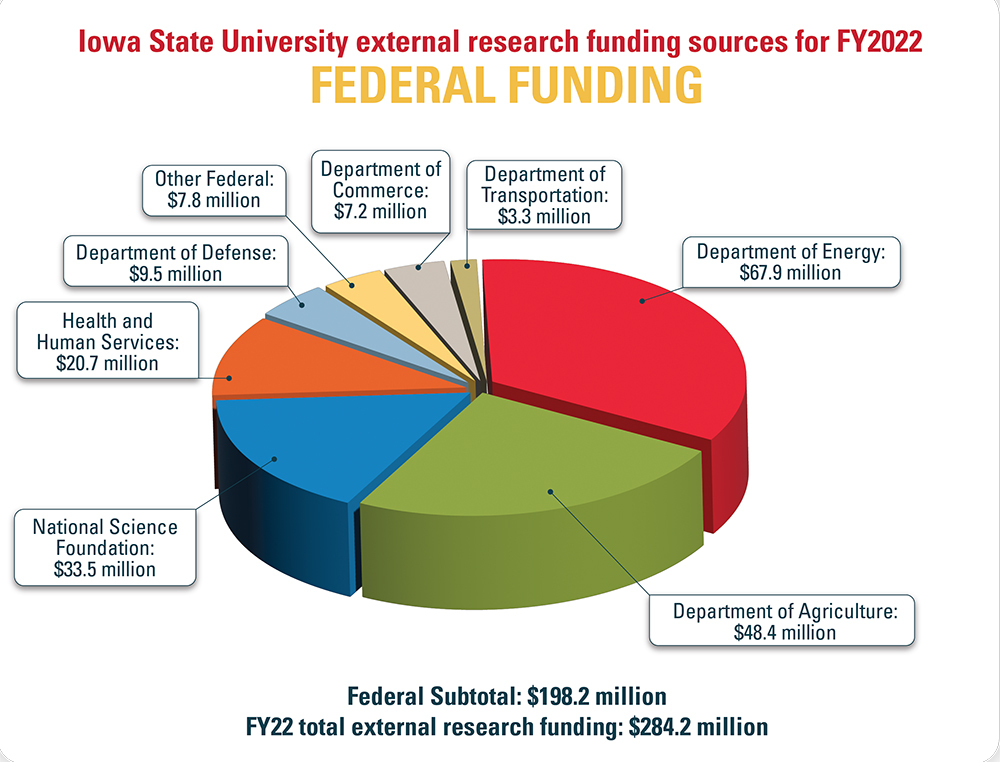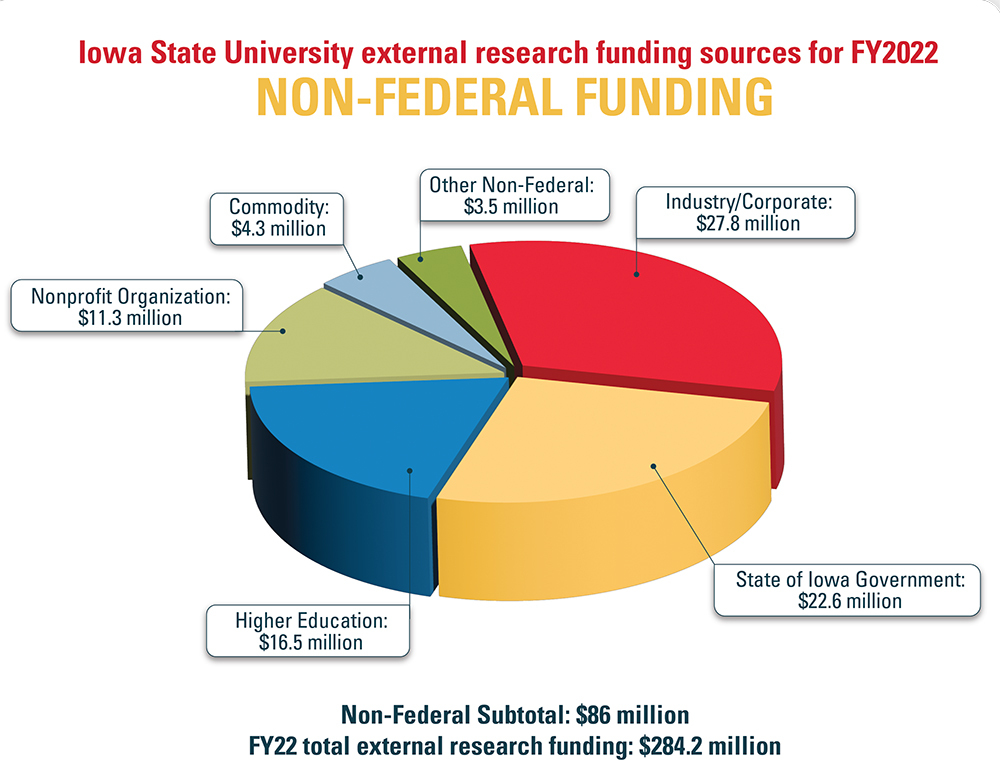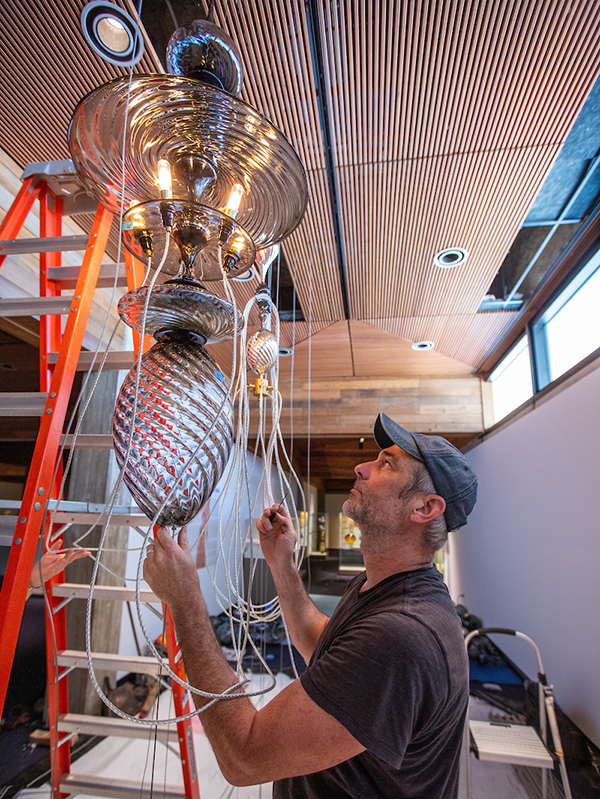Five questions with the steam tunnel tour guides
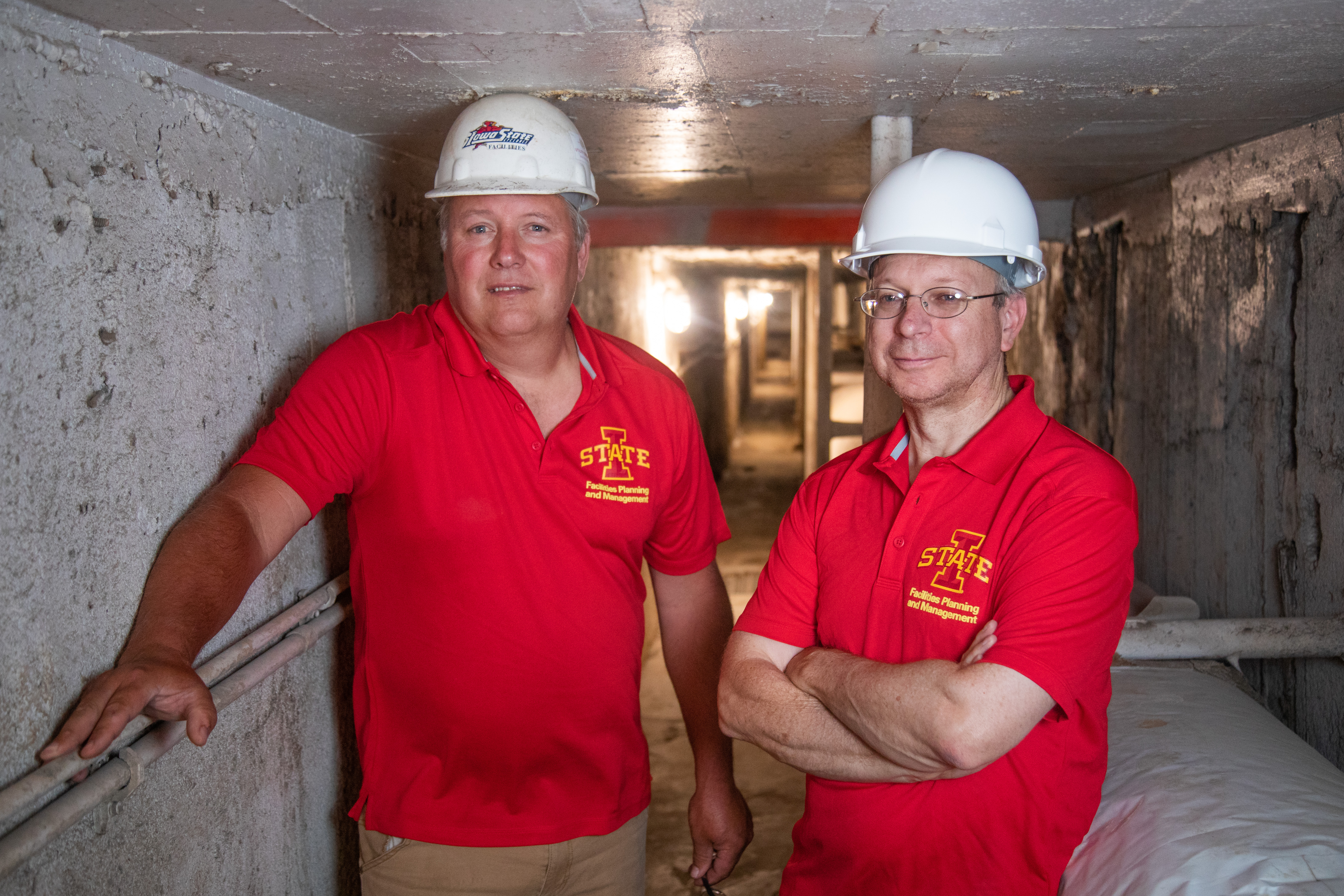
When campus groups tour Iowa State's steam tunnels, the guide is either manager of mechanical distribution David Frost (left) or Mike Murray, director of engineering for utilities distribution. Photo by Christopher Gannon.
Most faculty and staff work on campus. Mike Murray and David Frost work under it. They lead facilities planning and management efforts to plan, construct and maintain utility distribution systems, nearly all of which are below ground. As director of engineering for utilities distribution, Murray coordinates utility service for large projects. Frost, manager of mechanical distribution, oversees field operations and maintenance.
The basics
Name: Mike Murray
Position: Director of engineering for utilities distribution
Years at ISU: 25
Name: David Frost
Position: Manager of mechanical distribution
Years at ISU: 8
But for the 60 quick-acting employees who managed to secure the most in-demand offering of the inaugural Faculty and Staff Appreciation Week this spring, Murray and Frost might be better known as the steam tunnel tour guides. Slots for the appreciation week's four steam tunnel tours filled up the same afternoon they were made available.
"We were kind of strutting around a little bit about that," Murray said.
Murray and Frost alternate in leading tours of the tunnels, a sprawling network of subterranean structures built to house the pipes that deliver high-pressure steam to campus buildings. The passageways have been around nearly as long as the university and have expanded as the campus has grown, protecting pipes that take steam from the power plant to buildings -- primarily for heat and hot water. The first steam tunnel was constructed for Marston Hall about 120 years ago, and the most recent addition serves the Student Innovation Center.
Inside caught up with the steam tunnel experts recently to talk about their hot-ticket tours.
When did the steam tunnel tours start?
Murray: I’ve been here 25 years, and we did not do them for a long time, for no particular reason. Then about 15 years ago, I started giving the tours to student organizations. Honors groups and civil engineering groups, people like that. It was kind of a trickle, one or two a year. When Dave came eight years ago and became familiar with the system, he started doing some, too.
Frost: We started getting more interest, about that time. More interest than you could really handle.
Murray: And then after the staff appreciation week, the word must have gotten out. We have seen an increase in requests. We have had to be just a little bit more selective. We had one group that wanted to bring in 80 people in one afternoon.
Interested in a tour?
To arrange a steam tunnel tour, email Mike Murray at mimurray@istate.edu or David Frost at defrost@iastate.edu. The maximum group size is 15 people.
Why do you think people are so intrigued by steam tunnels?
Murray: Because of the mystery, from what I can tell. If you’re used to it, this is old hat. It’s a white hallway with pipes in it.
Frost: There's always somebody in the group that says, 'Well back when I was in college, we would try to enter the steam tunnels and check them out.'
Murray: There's a lot going on underground, but most people don't see that when they're walking around on the sidewalks. Their eyes are a little bit higher up or on their phones. They don’t notice the manholes, the little round iron discs over shafts that go down to domestic water valves, the rectangular hatches for the steam tunnels.
Frost: For us, the tours aren't just about the steam tunnels. I get to talk about all the other services that people take for granted. You turn the faucet on, and the water magically appears, right? I like to talk about the process of how it gets there. That’s why I enjoy it so much.
What kinds of questions do people ask?
Frost: I think the question we get asked the most is whether we use the tunnels to get across campus. Me? Absolutely I do. If it's 20 below out, I can walk into a tunnel and pop out in almost any building where I have a meeting. Do we allow anybody else? No, we don't.
Murray: There was an undergraduate student who had a research project proposing how we could convert the tunnels for pedestrians to use. There's not enough room, and I can just imagine that conversation: 'Your daughter was last seen going into this tunnel.'
Frost: I get asked about critters quite often, but we really don't have many problems with that. I always say we send in the tallest guy first to get rid of the spider webs. And every once in a while, an industrious ground squirrel will store their nuts on top of a warm steam line.
So why are tunnels better than burying steam lines?
Murray: It's a debate in the industry, but tunnel systems have a much longer life. And you can maintain them without disturbing the populace. Steam pipes inside our tunnels essentially have an indefinite lifespan. We see little signs of wear or aging. The buried pipes have a lifespan anywhere from five to 40 years. It's a wide range because it depends on how well it was installed, the soil type and whether it gets damaged. If someone's digging and they hit a steam tunnel, it goes clunk because they've hit a concrete wall. If someone comes through boring a fiber line, it can scrape through the insulation covering a buried steam line and damage it without us even knowing about it. Down at the Iowa State Center, the steam lines are buried. By 2015, that was a 50- or 60-year-old system, and it was failing all the time. We would be down there digging two or three times a summer to patch it. That would be a bit disruptive on campus. We've replaced all of the Iowa State Center system now. And it will have a five- to 40-year lifespan.
What's your favorite story to tell about the steam tunnels?
Murray: I'd say the fact that the first tunnel built on campus was made from arched brick and is still in pretty good shape. We can't get structural engineers to design us brick tunnels anymore because there are no design codes for them.
Frost: I always thought it was interesting, and I credit Mike for first noting this, that the powers to be who built Iowa State's power plant put it way, way, way off campus so there wouldn't be students around it. We've got old pictures where there are sheep out in fields where the plant is. That decision helped build the foundation of the steam tunnel network.
Heather Paris named to operations and finance interim post
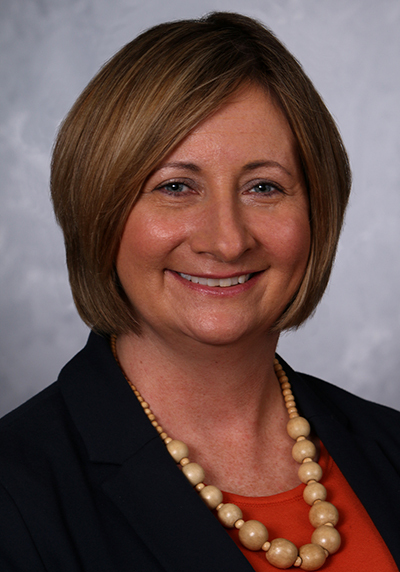
Heather Paris
President Wendy Wintersteen has appointed Heather Paris to serve as interim senior vice president for operations and finance, effective Sept. 7 and pending approval by the state Board of Regents.
Senior vice president Pam Cain previously shared her plans to retire this fall after 15 years of service at Iowa State University. Her last day will be Sept. 6.
Paris serves as associate vice president for finance services, overseeing procurement, accounts receivable and finance delivery. In her interim role, she will lead the operations and finance division that includes institutional financial strategy, finance services, payroll, benefits and tax accounting; facilities planning and management, business services and cultural arts.
"Heather will provide strong leadership for the division while we conduct a national search to permanently fill the position," Wintersteen said. "I know Pam and Heather will work together over the coming weeks to ensure a smooth transition."
The search process is being led by a committee chaired by David Spalding, Raisbeck Endowed Dean of the Ivy College of Business and interim vice president for economic development and industry relations, with support from Parker Executive Search. Monica Sasse, executive assistant to the Business dean, is providing committee support. Other search committee members are:
- Chris Johnsen, procurement manager, Iowa State Extension and Outreach and P&S Council past-president
- Surya Mallapragada, associate vice president for research
- Jon Perkins, associate professor of accounting and Faculty Senate president
- Ellen Reints, strategic budget and finance officer, office of the senior vice president and provost
- Adam Schwartz, director, Ames National Laboratory
- Carl Wells, director of equal opportunity and Title IX coordinator
Updates about the search can be found on the president's office administrative search website.
Related story
- Senior VP Cain will retire this fall, May 26, 2022
Welcome
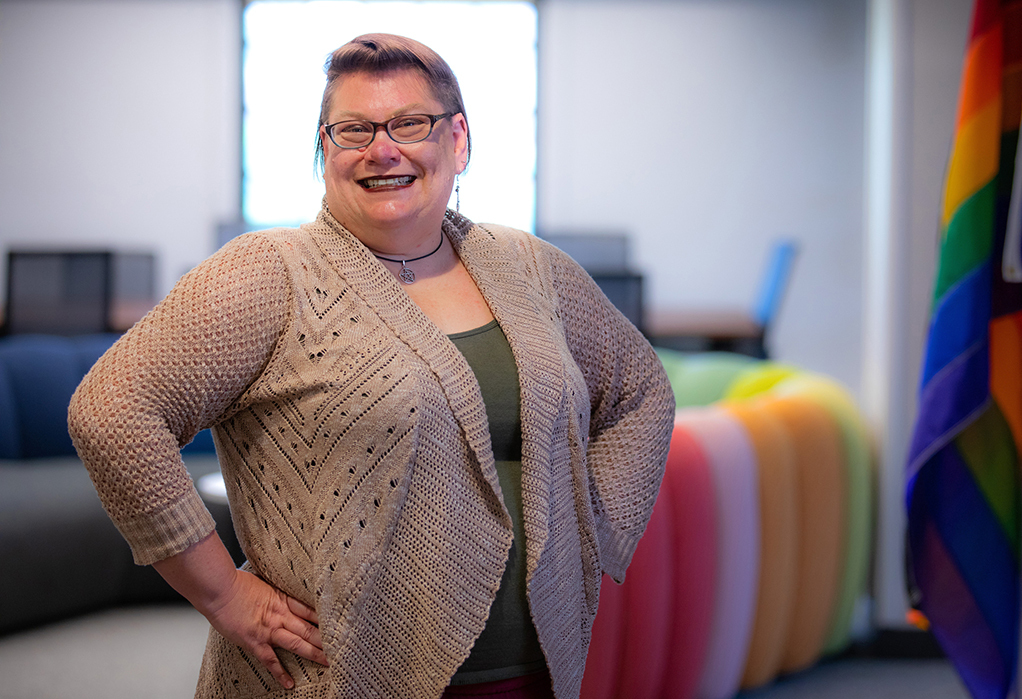
Susan Harper is the new director of the Center for LGBTQIA+ Student Success, which moved this summer to renovated space on the Memorial Union fourth floor. Photo by Christopher Gannon.
Susan Harper is the director of the Center for LGBTQIA+ Student Success, effective July 1. Following a few weeks of remote work, she arrived on campus this week.
"Dr. Sue" comes to Iowa State from the University of North Texas (UNT), Dallas, where she served as coordinator of multicultural student support services, overseeing multicultural, diversity and identity-based programs. Concurrently, she taught sociology courses at Texas Woman's University, Denton, for nearly a decade. Previously, she taught sociology, anthropology and women's studies courses at the University of Texas, Arlington; UNT, Denton; and several campuses of the Dallas County Community College District (now Dallas College).
Harper grew up in Yankton, South Dakota, and was college educated in Texas. She earned master's and doctoral degrees in cultural anthropology from Southern Methodist University, Dallas, where her work focused on identity construction within the Texas Neopagan community. She also earned a master's degree in multicultural women's and gender studies from Texas Woman's University and bachelor's degrees in English and anthropology from UNT, Denton.
She has presented her work on lesbian motherhood, Neopaganism, feminist pedagogy, adjunct exploitation, and qualitative inquiry as a tool for social justice at conferences. Her current project, schedule to be published in 2023 and which she co-authored, is on doing ethnography.
Harper is in the process of filling the center's other full-time position. She said the goal is to have an assistant director on board early in the fall semester.
In mid-May, the center moved to the renovated fourth floor of the Memorial Union. Harper's office is in 4600 MU. Contact her by email, drsusan@iastate.edu, or phone, 294-5424.
New employee benefit assists with adoption costs
Financial help is available to ISU employees who adopt a child, under a new benefit that took effect July 1.
Approved as a three-year pilot by the state Board of Regents at its June 2 meeting, the adoption assistance reimbursement program covers eligible expenses related to adopting a child, up to $5,000 per adoption. ISU brought the proposal to the board in response to an employee's request.
Providing financial support for employees adopting children is an increasingly common employee benefit, and offering adoption assistance at Iowa State takes into consideration that ISU-sponsored health plans cover most, if not all, of the medical expenses of birthing a child, said Ed Holland, director of benefits and WorkLife for university human resources. Under a longstanding policy, employees also may use up to five days of sick time to take time off when newly adopting a child.
"Iowa State University recognizes that families are built in many ways," Holland said.
The program covers adoption of any person under the age of 18 or physically or mentally incapable of self-care, other than the child of an employee's spouse or domestic partner. Use of the benefit is limited to two adoptions, for a lifetime maximum of $10,000. Siblings adopted simultaneously are considered one adoption.
The program is available to benefits-eligible faculty, staff and post-docs who have a regular or term appointment of at least half-time. If two parents adopting a child are both ISU employees, the household's combined reimbursement limit remains $5,000 per adoption for no more than two adoptions.
Adoption expenses that qualify for reimbursement include:
- Adoption agency and placement fees, including for home study
- Legal fees and court costs
- Required medical expenses, including immunizations
- Temporary foster care
- Immigration and translation
- Travel expenses, other than mileage and fuel
- Counseling associated with placement and initial adjustment
Expenses will be reimbursed after the adoption is finalized. Expenses and the adoption will require documentation. Reimbursement submissions will be administered by ASIFlex, the third-party vendor that manages ISU flexible spending account reimbursements for dependent care and medical expenses.
To be approved to use the program, employees must submit a request in Workday. The fringe benefit accounting and compliance team will determine eligibility and notify the requesting employee. See the program webpage for more information on how to submit a request.
Iowa State sets records in external funding and research funding
Iowa State University attracted a record $601.7 million in total external funding for the 2022 fiscal year that ended June 30. It's the first time Iowa State's external funding total has exceeded $600 million.
The new record is a jump of $42.6 million and 7.6% from the previous high of $559.1 million set in fiscal year 2021. The total includes a record amount of external support -- $284.2 million -- for sponsored research funding.
"Record external funding and sponsored research affirms Iowa State's excellence as a renowned research and land-grant university," said President Wendy Wintersteen. "Iowa State's research enterprise is flourishing in a university ecosystem devoted to innovation and entrepreneurial growth. Through our business and industry partnerships, research-based startups and career-ready graduates, Iowa State is accelerating the state's economic progress."
External funding supports initiatives across campus, including research projects, academic support, scholarships and facility improvements. The funding can include contracts, awards and cooperative agreements from federal, state and local governments, as well as from individuals, corporations, nonprofits and other universities. External funding supports research operating expenses, but it does not support operating expenses related to the university's education mission.
One major source of external funding is the Iowa State University Foundation, a private, nonprofit organization that secures and manages gifts benefitting the university. In FY22, the foundation's fundraising efforts resulted in $229.5 million in gifts received for the university, a jump of $78.5 million from FY21's $151 million.
Record external funds for research, innovation
Iowa State's record sponsored research is a jump of $23.3 million over the previous record of $260.9 million in FY19.
"Even during the height of the pandemic that impacted the 2021 fiscal year, the Iowa State research enterprise never really shut down," said vice president for research Peter Dorhout. "Nevertheless, it would be disingenuous to say it didn't have some effect, particularly on our people.
"The 2022 fiscal year reflects the resolve and excellence of our research faculty and staff and demonstrates that our partners in federal agencies, and in industry and nonprofits, truly value the creativity, expertise and innovation that the Iowa State research community brings to society's greatest challenges."
Examples of externally supported research projects include:
- Studying new approaches to cover crops, such as growing turf grass between rows of corn, to improve soil health, resource conservation and nutrient management. The project is led by D. Raj Raman, a Morrill Professor in agricultural and biosystems engineering, and supported by a grant of nearly $10 million from the U.S. Department of Agriculture's National Institute of Food and Agriculture.
- Using genome sequencing data to understand disease mutations and develop software that can make predictions and help doctors treat patients. The project is led by Robert Jernigan, a Charles F. Curtiss Distinguished Professor in Agriculture and Life Sciences, and supported by a $2.3 million grant from the National Institute of Health's National Human Genome Research Institute.
- Working to improve sustainability of the U.S. chemical industry by streamlining production systems and using biomass and renewable energy to produce high-value chemicals. The $2 million project is led by Jean-Philippe Tessonnier, the Richard C. Seagrave Associate Professor in Chemical and Biological Engineering, and supported by the National Science Foundation.
- Creating systems that support design and construction of quality, affordable housing in Iowa, including 3D-printed homes. The project is led by Pete Evans, assistant professor of industrial design, and supported by a $1.4 million grant from the Iowa Economic Development Authority.
"The record-setting investments by both federal and non-federal sources," Dorhout said, "reflect the Iowa State research community's relentless commitment to fruitful collaboration, deep analysis and research with integrity to unearth new technologies, science, perspectives and ideas that benefit a changing world."
Check the source of retirement planning offers
Preparing for your future is important, so make sure to seek out trusted advice when working with financial planners and retirement advisors.
Many faculty and staff recently have received email offers for financial and retirement planning that aren't connected with or endorsed by the university. The messages purport to be from an individual named "Alexa Brown" and encourage the recipient to schedule a consultation available to them as a "valued employee of Iowa State University" about topics such as Medicare coverage and retirement income.
The messages are solicitations a licensed independent insurance agent based in Missouri Valley, Iowa, is sending to state employees, said Rich Tener, ISU's chief information security officer.
"These emails and the services being offered are not affiliated with ISU," Tener said. "If you are not interested, we recommend unsubscribing or reporting the messages as junk (not phishing) through your email client to enhance Microsoft's spam filter."
University consultations
Iowa State employees have several options for free financial and retirement planning via university staff, partners and retirement savings vendors, said Ed Holland, director of benefits and WorkLife for university human resources (UHR).
TIAA, AIG and Ameriprise all offer individualized meetings with advisors, both in-person and virtually. TIAA advisors hold on-campus one-on-ones a few days a month, and AIG and Ameriprise agents are available to meet on-campus by request, as well.
On a quarterly basis, UHR holds a two-day workshop called Ready, Set, Retire, which includes presentations about Medicare, Social Security, ISU retiree benefits, TIAA and IPERS retirement plans, and the emotional and mental health impacts of retirement. Videos and slides from prior workshops are online, and the next Ready, Set, Retire event will be Sept. 29-30, Holland said. Employees can contact the UHR benefits office if they have specific questions about Medicare coverage.
Financial consultations also are available through the Employee Assistance Program and Financial Wellness at Work, a pilot project of ISU Extension and Outreach.
Former president Gordon Eaton has died
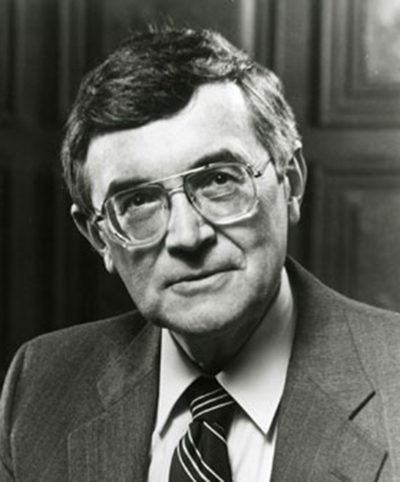
Gordon Eaton, 1986
Gordon Eaton, who served as Iowa State president from 1986 to 1990, died July 2 in Bryan, Texas. He was 93.
A memorial service will be held Friday, July 29, in Bryan. In retirement, Eaton and his wife, Virginia, returned to the College Station-Bryan area, where he had served for five years at Texas A&M University before arriving in Ames.
"While Gordon Eaton's tenure at Iowa State was relatively brief, the list of achievements under his leadership was long -- and have proven long-lasting," said President Wendy Wintersteen.
During the Eaton years, Iowa State increased financial support for undergraduate education and underrepresented student recruitment. Sponsored research funding doubled. The ISU Research Park was established on an initial 220 acres. Significant progress was achieved in growing the university's operating budget and making faculty salaries competitive.
"President Eaton characterized these and many other achievements as the result of effective collaboration and hard work by many dedicated people and partners," Wintersteen said. "Those attributes remain relevant today as we build upon the legacy of past leaders like Gordon Eaton."
Other accomplishments during Eaton's tenure included:
- Ongoing strategic planning was implemented.
- The Faculty Senate, with shared governance responsibilities, replaced a faculty council in 1988.
- Several research centers were created, including the Leopold Center for Sustainable Agriculture, and nine major buildings were completed, including Molecular Biology, National Soil Tilth Laboratory (now the National Laboratory for Agriculture and the Environment), Durham Center, Applied Science Center and the Lied Recreation/Athletics Center.
- Iowa State was selected as the secretariat for the World Food Prize, an initial role among many to come in a longstanding relationship with the Des Moines-based foundation.
Eaton residence hall on the west side of campus was named for Iowa State's 12th president when it opened in 2002.
Eaton, a geologist by training, left Iowa State to become director of Columbia University's Lamont-Doherty Earth Observatory north of New York City, "an offer I have decided I cannot refuse" he said at the time. In 1994, President Bill Clinton appointed him director of the U.S. Geological Survey, headquartered in Reston, Virginia, the position from which he retired in 1997.
Earlier in his career, from 1967 to 1981, Eaton held various positions with the geological survey in Virginia, Hawaii, Colorado and Washington, D.C. His return to higher education began in 1981, when he served as dean of the College of Geosciences (1981-83) and provost and vice president for academic affairs (1983-86) at Texas A&M.
Eaton, a native of Dayton, Ohio, earned a B.A. in geology (1951) from Wesleyan University, Middleton, Connecticut, and an M.S. in geology (1953) and Ph.D. in geology and geophysics (1957) from California Institute of Technology, Pasadena.
Memorial gifts may be made to the Arbor Oaks at Crestview Residents Association, Memorial Garden Fund, at 2505 E. Villa Maria Rd., Bryan, Texas 77802.
P&S Council seeks return to prior tuition payback policy
A benefits program that allows staff to be reimbursed for up to 12 credits of college tuition per year was adjusted in 2020 to cover only Iowa State coursework. The Professional and Scientific Council is considering a recommendation to senior leaders to roll back the change, again allowing reimbursement for tuition paid to other institutions.
At the council's July 7 meeting, Erin Gibson, chair of the council’s compensation and benefits committee, presented the first reading of a motion recommending a return to the previous tuition reimbursement policy.
Under current rules, benefits-eligible P&S and merit staff who have been employed at least one year can apply for reimbursement for up to four ISU credits per semester during fall, spring and summer sessions. Narrowing the program to ISU classes was part of a variety of cost-cutting actions announced in July 2020 to help manage a leaner fiscal year 2021 budget. Council president Jamie Sass said removing that limitation is something she's had her eye on as a council priority.
Gibson said asking senior leaders to reinstate the prior rules was the simplest option for addressing the restriction. A suggestion by one council member to make the change retroactive was not added to the motion.
"That's a big ask. It would almost be a whole other motion," said Patrick Wall, council president-elect and former chair of the compensation and benefits committee.
The council will vote on the motion at its Aug. 4 meeting.
Setting a course
Council members spent much of the July meeting brainstorming ideas to consider for the council's 2022-23 strategic initiatives. The council sets strategic initiatives annually in the summer, based on ideas from members. The council will vote on the initiatives in August.
"We're trying to create actionable items that would benefit all or most of P&S employees," Sass said.
Sick time conversion update
At its April meeting, the council passed a motion requesting that university human resources provide more information about a technical issue that temporarily and incorrectly prevented some employees from converting sick time off to vacation time, which employees can do on an opt-in basis after accruing 240 hours of sick time. (The conversion rate provides vacation credit equal to one-third of that month's accrued sick time, in any month when an employee doesn't use sick time off.)
The situation occurred when employees changed positions and has since been addressed through an ongoing audit process. Thirteen staff who have already left Iowa State were impacted, and those former employees were contacted and paid for the vacation time they should have accrued, Gibson said.
UHR also has since notified the current employees affected and will adjust their sick time and vacation credit balances accordingly.
Commissioned glass art fits in at the Brunnier
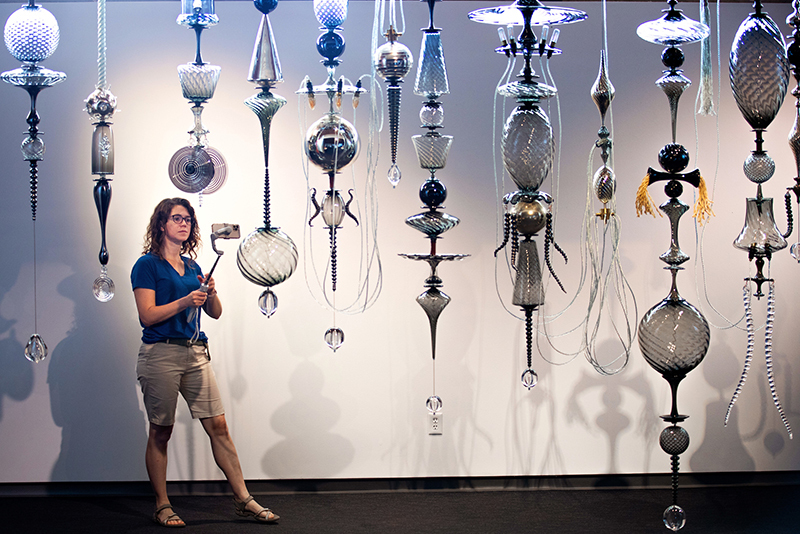
University museums staff member Alisha Abner captures video of glass artist Andy Paiko's installation at the Brunnier Art Museum earlier this week. Photos by Christopher Gannon.
When it reopens Aug. 24, one of the new exhibitions at the Brunnier Art Museum, Scheman Building, is a multi-piece, floor-to-ceiling glass screen in the naturally lit east part of the museum. University museums commissioned Portland glass artist Andy Paiko to create an Iowa State-specific installation that "reflects the imagery and innovation" of the university, for example the Marston water tower (below) or a cyclone. Paiko was on campus last week to install his latest work, Refraction Summary, which becomes part of the museums' permanent collection.
University museums galleries will close at the end of the day July 22 for several weeks to give staff time to install more fall exhibitions and reopen the first week of fall semester.

Detail of the exhibit reveals a Marston water tower replica inside one of the glass globes.
